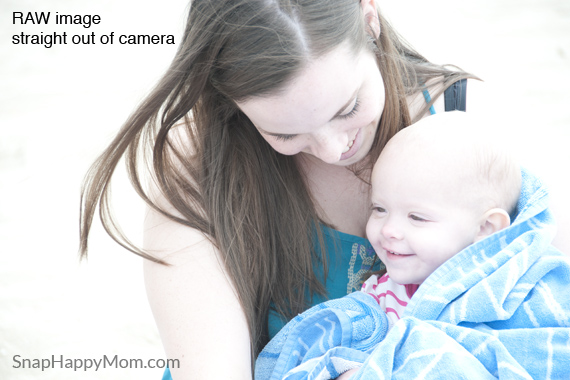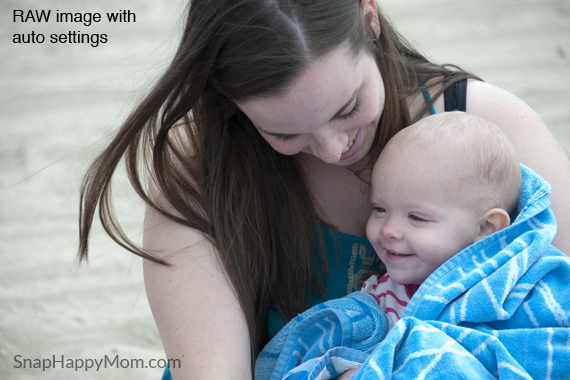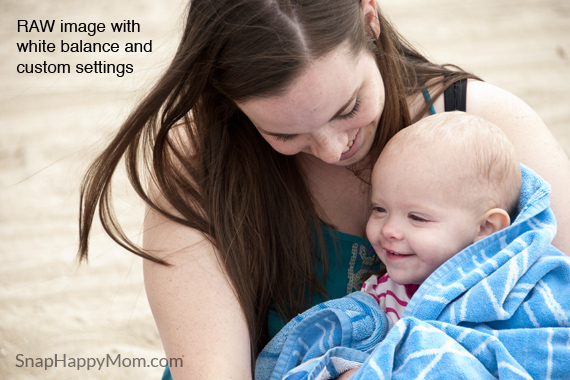If you have a DSLR camera, you might know about shooting in raw. I'll have to cover the pros and cons of working in raw another day, but here's an example of the MAJOR reason for choosing to shoot picture in raw format. You can "save" or fix pictures so easily!
Here's Brighton in her Aunt's lap at the beach. It turns out I over exposed the picture, and it looks way too bright:
Umm, does she even have a shoulder? It's seriously washed out. And you can't even tell they are at the beach! This picture has potential, but needs some help.
Never fear, I took this picture in RAW format. And it can be saved.
Here's what the picture looks like after opening it in Adobe's Camera Raw platform.
All I did was hit "auto" for the exposure settings and behold, Aunt has a shoulder and Brighton has a head! It's better already.
This is possible because of the raw format. Long story short, raw format is a not exactly a picture, it's the complete record of all the information from your camera's sensor. All that information is read as an image that is easy to manipulate and fix. Then you can save an actual image file like jpeg or tiff, but your original camera files were never touched.
In our example, the camera recorded information that defined the Aunt's shoulder, the back of the baby's head, and the sand. That information exists, but the sun was so bright that everything appears to be bright and washed out. Editing the raw file allows that information to show up again, and define the sand and the edges better.
The point is, a jpeg file can be edited, but everything you do to it is technically destroying information. Raw editing is nondestructive, because you are changing how the information is read, not the information itself (for instance, telling the darks to appear darker, or the red areas to look brighter). You can "rescue" many pictures that were taken in raw that would be a lost cause if they were taken as a jpeg.
Here's that same picture with a few custom setting applied (white balance, contrast, brightness, etc). It's a cute picture after all!
If I had taken this as a jpeg file, then I'd be stuck with something like the top picture: washed out and too bright. I might be able to make it look slightly better, but it would be a harder and longer process, and my efforts to fix certain areas of the photos would make other areas look funny. It's way better to shoot in raw, fix things in a few clicks, and then export to a jpeg file.
It took a long time for me switch over to shooting in raw, but I am so glad I did. There are so many pictures that I've edited to a useable level that were not acceptable in jpeg. Give it a try!
For a more specific definition of the raw format, check out this post and for more information about how to open and utilize raw images see this post. Any questions for me?





Stacie says
That is amazing! Is there a reason you wouldn't shoot in raw all the time?
Jen says
Same question as Stacie, above! Why would you not shoot in raw, besides the fact that it takes up more space on your camera, computer etc? I have another question too - If I were to ever own a nice camera, do I have to buy super expensive nice software to edit the photos?
Meg says
Great questions, which I plan on answering further in a post soon. But here's the two big reasons that you might choose not to shoot in raw.
1) Raw files are much, much bigger than jpeg files. They take up more room on your memory card, and more room on your computer for long term storage. Of course, this might not be an issue if you're using large capacity memory cards and hard drives, but it's worth noting. My smallest memory card is 4 GB, and it holds almost 200 raw files, compared to 1,400 of the highest-quality jpeg files. This will differ according the the camera and settings, but recognize that raw files take up at least five times the space that jpegs do.
2) Because a raw file is not technically a picture, you cannot just pop your card into the computer and upload the photos to a printing service or the web. You MUST take another step and edit them to be able to save as a jpeg/tif/etc. There is free software available to do this, but you can't skip it. So, it's a commitment of time, because you'll have to open each raw file you're interested in and re-save as a picture file. I usually do some basic editing before I save to jpeg, but you don't have to if the picture looks good to you.
I don't mind editing each picture, but that is the reason I am perpetually behind on editing my family's pictures 🙂
Stay tuned for more explanations of these pros and cons , and how to decide on a case-by-case basis!
Don says
Well crafted explanation! Great job.